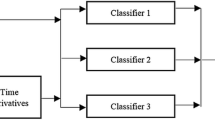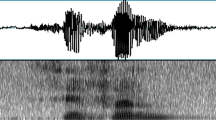Abstract
In this paper we focus on the anti-phoneme modelling part of segment-based speech recognition, where we have to distinguish the real phonemes from anything else which may appear (like parts of phonemes, several consecutive phonemes and noise). As it has to be performed while only having samples of the correct phonemes, it is an example of one-class classification. To solve this problem, first all phonemes are modelled with a number of Gaussian distributions; then the problem is converted into a two-class classification task by generating counter-examples; this way some machine learning algorithm (like ANNs) can be used to separate the two classes. We tested two methods for a counter-example generation like this: one was a solution specific to the anti-phoneme problem, while the other used a general algorithm. By making modifications to the latter to reduce its time requirements, we were able to achieve an improvement in the recognition scores of over 60% compared to having no anti-phoneme model at all, and it performed considerably better than the other two methods.
Preview
Unable to display preview. Download preview PDF.
Similar content being viewed by others
References
Tax, D.M.J.: One-class classification; Concept-learning in the absence of counter-examples. PhD thesis, Delft University of Technology (2001)
Glass, J.R.: A probabilistic framework for segment-based speech recognition. Computer Speech and Language 17(2), 137–152 (2003)
Tóth, L., Kocsor, A., Gosztolya, G.: Telephone speech recognition via the combination of knowledge sources in a segmental speech model. Acta Cybernetica 16(4), 643–657 (2004)
Bishop, C.M.: Neural Networks for Pattern Recognition. Clarendon Press, Oxford (1995)
Schölkopf, B., Platt, J.C., Shawe-Taylor, J., Smola, A.J., Williamson, R.C.: Estimating the support of a high-dimensional distribution. Neural Computation 13(7), 1443–1471 (2001)
Bánhalmi, A., Kocsor, A., Busa-Fekete, R.: Counter-example generation-based one-class classification. In: Kok, J.N., Koronacki, J., Lopez de Mantaras, R., Matwin, S., Mladenič, D., Skowron, A. (eds.) ECML 2007. LNCS, vol. 4701, pp. 543–550. Springer, Heidelberg (2007)
Duda, R., Hart, P.: Pattern Classification and Scene Analysis. Wiley & Sons, New York (1973)
Author information
Authors and Affiliations
Editor information
Editors and Affiliations
Rights and permissions
Copyright information
© 2009 Springer-Verlag Berlin Heidelberg
About this paper
Cite this paper
Gosztolya, G., Bánhalmi, A., Tóth, L. (2009). Using One-Class Classification Techniques in the Anti-phoneme Problem. In: Araujo, H., Mendonça, A.M., Pinho, A.J., Torres, M.I. (eds) Pattern Recognition and Image Analysis. IbPRIA 2009. Lecture Notes in Computer Science, vol 5524. Springer, Berlin, Heidelberg. https://doi.org/10.1007/978-3-642-02172-5_56
Download citation
DOI: https://doi.org/10.1007/978-3-642-02172-5_56
Publisher Name: Springer, Berlin, Heidelberg
Print ISBN: 978-3-642-02171-8
Online ISBN: 978-3-642-02172-5
eBook Packages: Computer ScienceComputer Science (R0)




